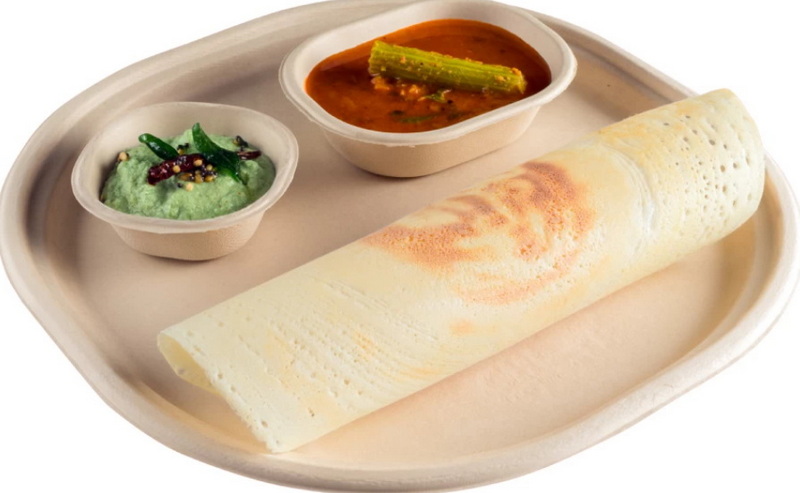
Content Menu
● Introduction to Disposable Dosa Plates
>> Materials Used in Disposable Dosa Plates
● Health Risks Associated with Disposable Dosa Plates
>> Chemical Leaching
>> Microbial Contamination
● Eco-Friendly Alternatives
>> Biodegradable Plates
>> Reusable Options
● Practical Considerations for Choosing Disposable Dosa Plates
● Impact on the Environment
● Future Directions
● Consumer Awareness and Regulatory Frameworks
● Economic Considerations
● Cultural and Social Implications
● Conclusion
● FAQ
>> 1. What are the common materials used in disposable dosa plates?
>> 2. Are biodegradable plates completely safe for food?
>> 3. Can disposable plates leach chemicals into food?
>> 4. How can I ensure the safety of disposable dosa plates?
>> 5. What is the most environmentally friendly option for dosa plates?
In recent years, the use of disposable dosa plates has become increasingly popular, especially in large gatherings and events. These plates are often made from materials like paper, plastic, or biodegradable alternatives such as sugarcane bagasse or bamboo. However, concerns have been raised about their safety for food, particularly regarding chemical leaching and microbial contamination. This article will delve into the safety aspects of disposable dosa plates, exploring their materials, potential health risks, and eco-friendly alternatives.

Introduction to Disposable Dosa Plates
Disposable dosa plates are designed for convenience, offering a hassle-free dining experience without the need for washing. They are commonly used for serving dosas, a popular Indian dish, along with various condiments and chutneys. The choice of material for these plates varies widely, impacting both their environmental footprint and safety for food use.
Materials Used in Disposable Dosa Plates
1. Paper Plates: These are often coated with wax or plastic to make them more resistant to moisture. However, some coatings may contain chemicals like PFAS, which have raised health concerns. PFAS, or per- and polyfluoroalkyl substances, are known for their non-stick properties but have been linked to health issues such as obesity and organ damage.
2. Plastic Plates: Made from food-grade plastics, these are durable but contribute significantly to plastic waste and microplastics in the environment. The production and disposal of plastic plates pose substantial environmental challenges, including pollution and harm to wildlife.
3. Biodegradable Plates: Materials such as sugarcane bagasse, bamboo, and palm leaves are becoming popular alternatives. They are compostable and reduce environmental impact but may still pose health risks if not produced with safe chemicals. The production process of these plates must ensure that no harmful substances are used, which can be a challenge in some manufacturing settings.
Health Risks Associated with Disposable Dosa Plates
Chemical Leaching
One of the primary concerns with disposable plates is the potential for chemicals to leach into food, especially when heated. PFAS, used in some paper plates, have been linked to health issues such as obesity and organ damage. Similarly, plastic plates can release chemicals when exposed to high temperatures or fatty foods. This risk is particularly concerning for children and pregnant women, who may be more susceptible to the adverse effects of these chemicals.
Microbial Contamination
Disposable plates can become contaminated with bacteria if not handled properly. This risk is heightened in environments where hygiene standards are not strictly maintained. In outdoor events or mass gatherings, ensuring that plates are stored and distributed in a clean manner is crucial to prevent foodborne illnesses.

Eco-Friendly Alternatives
Biodegradable Plates
Biodegradable plates made from natural materials like sugarcane bagasse or bamboo offer a more sustainable option. They are compostable, reducing landfill waste and the environmental impact associated with traditional plastics. However, it's essential to ensure that these plates are produced using processes that minimize chemical use and are certified safe for food contact.
Reusable Options
The most environmentally friendly choice is to use reusable plates made from materials like ceramic or stainless steel. While they require washing, they significantly reduce waste and eliminate the risk of chemical leaching. Reusable plates also provide a cost-effective solution in the long term, as they can be used multiple times.
Practical Considerations for Choosing Disposable Dosa Plates
When selecting disposable dosa plates, it's crucial to consider both safety and sustainability. Here are some practical tips:
- Check for Certifications: Look for certifications from reputable organizations that ensure the plates meet safety standards for food contact.
- Choose Biodegradable Options: Opt for biodegradable plates made from natural materials whenever possible.
- Avoid Heating: Avoid heating food directly on disposable plates to minimize chemical leaching.
- Proper Handling: Ensure that plates are handled and stored in a clean environment to prevent microbial contamination.
Impact on the Environment
The environmental impact of disposable dosa plates cannot be overlooked. Traditional plastic plates contribute to the staggering amount of plastic waste in landfills and oceans. In contrast, biodegradable plates offer a greener alternative by reducing waste and promoting composting. However, the production process of these plates must also be environmentally friendly to maximize their benefits.
Future Directions
As consumers become more environmentally conscious, the demand for sustainable disposable products is increasing. Manufacturers are responding by developing more eco-friendly materials and production processes. The future of disposable dosa plates likely lies in innovative biodegradable materials that are both safe for food and gentle on the environment.
Consumer Awareness and Regulatory Frameworks
Consumer awareness plays a crucial role in driving demand for safer and more sustainable products. Governments and regulatory bodies are also implementing stricter guidelines to ensure that disposable plates meet safety standards. This includes regulations on the use of harmful chemicals and standards for biodegradability.
Economic Considerations
While disposable plates are often seen as a cost-effective option, their long-term impact on health and the environment can lead to significant economic burdens. Reusable plates, although requiring an initial investment, can be more cost-effective over time. Additionally, the shift towards biodegradable materials can create new economic opportunities in sustainable manufacturing.
Cultural and Social Implications
The use of disposable dosa plates also has cultural and social implications. In many societies, the shift towards disposable products reflects changing lifestyles and increased convenience. However, this shift must be balanced with environmental responsibility and health awareness. Cultural events and festivals can serve as platforms to promote sustainable practices and raise awareness about the importance of eco-friendly choices.
Conclusion
Disposable dosa plates can be convenient but come with potential health and environmental risks. While biodegradable options offer a greener alternative, ensuring they are produced with safe materials is crucial. For maximum safety and sustainability, reusable plates remain the best choice. By understanding the pros and cons of different materials and choosing wisely, we can enjoy the convenience of disposable plates while protecting our health and the environment.

FAQ
1. What are the common materials used in disposable dosa plates?
Disposable dosa plates are typically made from paper, plastic, or biodegradable materials like sugarcane bagasse and bamboo.
2. Are biodegradable plates completely safe for food?
Biodegradable plates are generally safer than traditional plastics but may still contain chemicals like PFAS if not produced carefully.
3. Can disposable plates leach chemicals into food?
Yes, some disposable plates, especially those with plastic coatings, can leach chemicals into food when heated.
4. How can I ensure the safety of disposable dosa plates?
Always check the packaging for microwave safety and avoid using plates with known harmful coatings like PFAS.
5. What is the most environmentally friendly option for dosa plates?
Reusable plates made from materials like ceramic or stainless steel are the most environmentally friendly option.

















